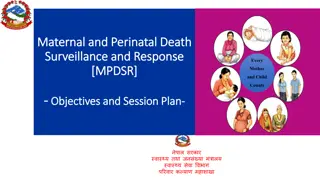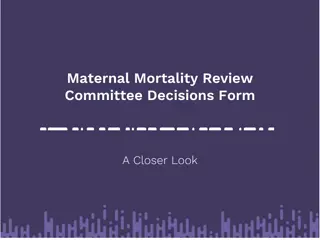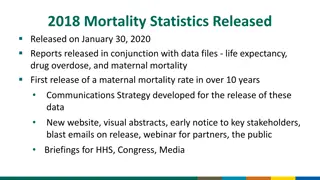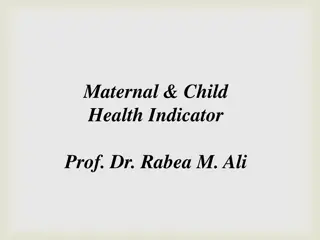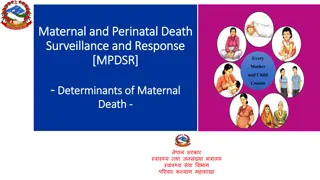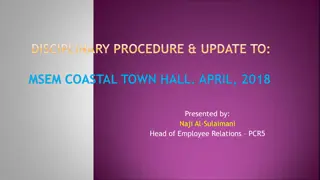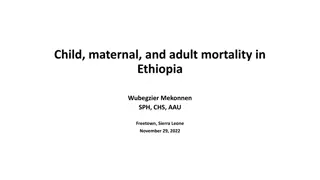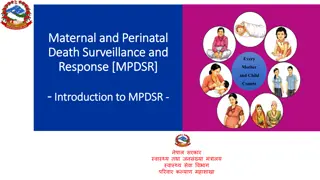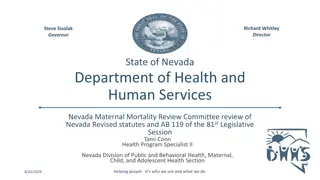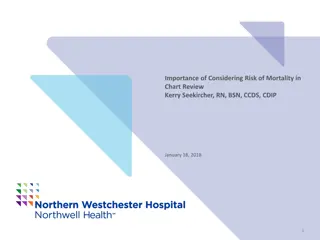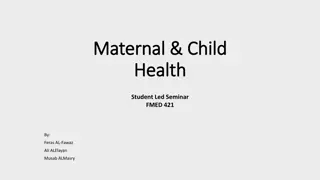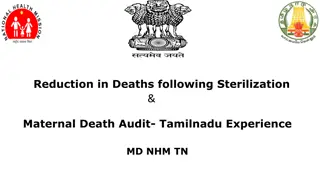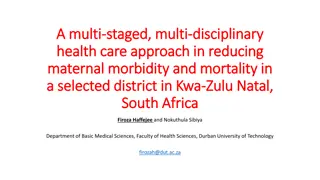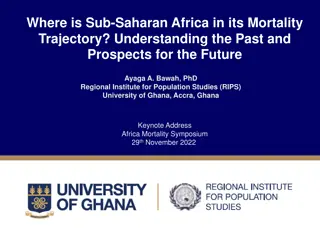A Multi-disciplinary Analysis of Service Access, Community Resilience, and Maternal Mortality in Gulf Province
This paper presents a comprehensive analysis focusing on service access, community resilience, and maternal mortality in Gulf Province, Papua New Guinea. It highlights the importance of improving referral systems for maternal health in remote communities and discusses the preliminary findings from a larger study on cross-sectoral factors influencing maternal mortality. Definitions related to maternal death and mortality rates are also provided, along with research questions aimed at identifying causes of maternal mortality during different stages of pregnancy. The study aims to advocate for better community education and decision-making regarding maternal health.
Download Presentation

Please find below an Image/Link to download the presentation.
The content on the website is provided AS IS for your information and personal use only. It may not be sold, licensed, or shared on other websites without obtaining consent from the author. Download presentation by click this link. If you encounter any issues during the download, it is possible that the publisher has removed the file from their server.
E N D
Presentation Transcript
A Multi-disciplinary analysis of service access, community resilience, and maternal mortality in Gulf Province Jennifer Litau, Ellie Korave,Hilda Tanimia Poisy Kae, Lucy Kalep, Kenny Abau, McKenzie Maviso,Kia-Henry Nema, Anne Litau 1
Acknowledgements Pacific Adventist University, Papua New Guinea Investigators of the study and their families. Sr Lucy Kalep (Right in the photo) & family Kerema General Hospital (KGH - Management and Staff), Gulf Province, PNG Gulf Provincial Health Department, PNG Villagers of Meii No. 1 & 2, Sori No 1, Mamuro, Siviri and Karama in Kerema District, Gulf Province, PNG 2
Presentation Outline Purpose Research Questions Brief Overview of Literature Background to Gulf Province Methodology Results Findings and Discussion Conclusion 1. 2. 3. 4. 5. 6. 7. 8. 3
1. Purpose of this paper Useful for advocacy in community education and decision-makers that referral systems need to be improved Maternal deaths in remote communities result from a multiplicity and complexity of factors and trends in existence 4
2. Sub-study of a large study LARGE STUDY The influence of cross- sectoral factors on maternal health and maternal mortality in Gulf PNG 2017- Describes preliminary results/findings Sub-study of larger study 5
Definitions 1. Maternal death or mortality (MM): 3. Maternal mortality ratio or rate (MMR): Death of a woman while pregnant or within 42 days of termination of pregnancy. Number of women who die, including abortions from pregnancy or childbearing- related complications in a given year per 100, 000 live births in that year. 2. Pregnancy-related death is used when attribution factors are unknown. (UN 2015, Zureick-Brown et al 2013, Mola & Kirby 2013, Haupt et al 2011, NSO 2009) 6
3. Larger Study Research Questions Large study Research Questions. To identify direct obstetric causes of MM, indirect obstetric causes, non obstetric causes, and linkages between obstetric and non-obstetric causes, during antepartum, intrapartum and postpartum stages. 1) 2) 3) 4) 7
4. Brief overview of literature 4.1 4.2 4.3 4.4 4.5 Maternal mortality an international development priority Maternal health is a PNG national priority Knowledge/data gaps addressed Vertical (top-down) access issues for service delivery Horizontal (bottom-out) access issues for services. 4.5a) People needing services 4.5b) Poor or lack of health services 4.5c) Rural health services neglected 4.5d) Women fear health system Services access complicated by multiplicity and complexity of factors Service access issues for poorer remote women for higher MMRs Remote and treatment facility access issues for high MMR Remote access to skilled supervised delivery or emergency care a community decision-making and referral systems challenge 4.6 4.7 4.8 4.9 8
4.1 Maternal mortality reduction is an international development priority. The SDGs 2030 require a whole-of-society approach (UN 2015, Dain 2015, Zureick- Brown et al 2013) Source: https://www.unfpa.org/data/world- population-dashboard 9
4.2 Maternal health is a national priority Key Result Area 5 National Health Plan 2011-2020 Objective 5.1 Improve family planning coverage. Objective 5.2 Provide safe and supervised deliveries. Objectives 5.3 Improve access to emergency obstetric care (EOC) Objective 5.4 Improve sexual and reproductive health for adolescents. (PNG National Department of Health 2010, PNG National Health Department 2009) 10
4.3 Knowledge gaps addressed Structural and infrastructural inefficiencies Intervention issues No vital registration 4.2. Addresses knowledge, data and intervention research gaps Complexity and multiplicity of factors affecting maternal mortality 85% rural people and limited access to health facilities. Data access issues (Mola & Kirby 2013, PNG National Department of Health 2009, PNG National Statistical Office 2006, PNG National Statistical Office 1996) 11
4.4 Access (top-down) issues for delivery of health/services in PNG Access and inequity important in calculations of MMR (Mola & Kirby 2013) Ministerial Taskforce on Maternal Health in Papua New Guinea The doubling of PNG s MMR as measured by the Demographic Health Surveys (DHS) of 1996 and 2006 is a clear reflection of the failure of access to and the delivery of quality of health services over the last 10- 15 years. (National Department of Health 2009, vi) 12
4.5a Access issues affecting people needing health/services Ministerial Taskforce on Maternal Health in PNG in their executive summary (National Department of Health 2009) PNG with MMR 733 was 2nd highest in Asia Pacific Region. Most complications in pregnancy will occur in low risk women: 15% of antenatal women, 15% of women in labour or delivery, and 15% of women in postpartum (lasting 6 weeks) Only 15% predicted upon case history Major direct cause: Obstetric haemorrhage Major indirect causes: Malaria and HIV/AIDS Maternal deaths occur in hospitals: 88-89% of deaths are preventable. 13
4.5b Access constrained by poor or lack of health services Deteriorating health services PNG people s confidence in the existing health system is poor Prevention and promotion services underutilised or accessed: low antenatal coverage, low supervised delivery rates, little postpartum care, low contraception, and low and static outreach in provinces. 14
4.5c Access constrained by neglect of rural health Rural health had improved little in last 30 years (since 1979) and is at the core of the problem of low maternal health status. Decrease in delivery rooms with running water Insufficient supply of drugs Reduced doctor supervisory visits Closed aidposts (in 2000 only 63% original ones operating) Between 1987 and 2000 decline in rural health facility staff especially CHWs Antenatal coverage lower Low contraceptive use Poor TB control Shortage of anti-malarials Decrease in ambulatory care Declining health infrastructure Prevailing low rates of supervised deliveries 15
4.5d Access constrained by lack of womens confidence in health system Women do not trust the health system to look after them respectfully and safely Marginalised women are Too young or too old Too many pregnancies Too close together pregnancies Too sick Too far from services Too poor, illiterate, too isolated, etc To vulnerable young, PLHIV, violence survivors, disabled (physically, mentally, intellectually) 16
4.6 Access to services complicated by multiplicity and complexity of factors influencing maternal health Delivery of social services in PNG has always been a challenge: access related to roads and transport, seasonal variation in conditions, issues around law and order, community education and literacy, challenges related to logistics of supply re-supply and issues related to human resource management, including performance management (good and poor). challenged status of women, and the relative lack of knowledge and involvement of men regarding Sexual and Reproductive Health issues (including their own). (National Department of Health 2009, vi) 17
4.7 Remote people access issues to facility and supervised delivery for higher MMR Mola & Kirby (2013) Higher MMR for about 60% births in remote or poor areas without access to facilities or services or infrastructure, markets and transportation. MMR in 2009 for remote areas with no road access to facility was 900 % of women accessing facility-based, supervised birth has decreased from 60% after independence to 37-41% in 2009. Health Information Systems (HIS) data 2009 indicated 35% PNG women of such areas never attended ANC during pregnancy. Women prefer a facility-based delivery but access and inequity will prevent them. 18
4.8 Remote and facility treatment access issues in PNG for high MMR trend Reference Source Year 1990- 2015 Place MMR PNG's Estimated MMR 1990-2012 Trend UN(2015) World 216 1000 Mola & Kirby (2013) WHO 1990 PNG 930 390 476 330 372 310 371 313 470 270 733 250 312 438 394 230 460 930 UN MMEIG IHME UN MMEIG PNG DHS UN MMEIG IHME 900 1995-96 800 733 2000 700 600 UN MMEIG 2005 476 470 NSO(2006) Mola & Kirby (2013) WHO 2006 2008 PNG 500 460 438 394 390 IHME 372 371 400 330 329 Mola & Kirby (2013) Health Information System Facility Based Survey UN MMEIG (HIS) IHME 2009 2009 2010 2010 2011 2012 PNG PNG 313 312 310 288.9 270 300 250 230 200 288.9 329 100 UN MMIEG: UN Maternal Mortality International Estimates Group 0 1990 1995-96 2000 2005 2006 2008 2009 2009 2010 2010 2011 2012 19 IHME: Institute for Health Metrics and Evaluation
4.9 Remote access to skilled supervised delivery or emergency care a community decision-making and referral systems challenge A maternal death may reveal deficiencies in community-decision making or difficulties in arranging a referral ( Mola & Kirby 2013) for Community to improve on, and Decision-makers to improve referral systems. 20
5. Background on Gulf Province 1. Geography constrains access to services Area is 13,500 km2 Dominated by mountains, sea, lowland meandering rivers, swamps, and deltas, grassland plains. Highest peak is 2775m (2.775km) The Kikori, Turama, Purari and Vailala rivers all meet the sea of Gulf of Papua. 5. Background of study 2. Population trapped in rough and poor environments Population (2011 Census) 158,197 which 2% of PNG s 7m people (2011 Census) 96% lived in rural locations and only 6% in urban in 2011. Sparse distribution Only 4% of its 2011 population with ease of access to Kerema Provincial Hospital Geography influenced population distribution. 3. Inadequate road network and transportation constrains access to service delivery and access Main major road POM-Kerema over 200km road serviced by PMVs and private vehicles. 21
5. Background to study continued 4. Access is limited private motor vehicles/boats major modes of transportation. 5. Canoes commonly used by rural river/sea people but inadequate to save a life in an obstetric emergency. 6. Cultural and gender positionality access issues: 89 in 2016 health rural facilities staffed by male mainly CHW constrain to women s access of facilities 7. Predominantly rural and high information illiterate population 22
ACCESS 9. Temporal (Time)-- 1 day travel indicates remoteness 10. Spatial access barriers (relative distance) 11. Locational access (physical distance-Km) 12. Transportation/infrastructural access 13. Communication access 14. Social access 23
15. Balanced dietary and nutritional access issues 16. Soil fertility access issues for subsistence production for food/sales. 24
17. Poor environment, poor access and low income Most disadvantaged are in the Lohohiki, Ivori, Nkevi and Mbwei valleys, west of Kaintiba and Purari Valley Constrained by poor environments Poor access to services Very low incomes Three quarters of people in the province live in low potential environments too rugged or too wet and swampy 25
18. Even women access to facility-based births do not guarantee maternal survival Adapted from Table 2. Provincial facility-based births and maternal death data received by mail survey with email and phone follow-up, November 2010, and provincial visits, 2011 Provincial referral hospital Births Maternal Government health centres Births Maternal Church agency health facilities Births Maternal Total Births Maternal Province Deaths MMR Deaths MMR Deaths MMR Deaths MMR Gulf 323 1 310 480 6 1,250 548 17 3,102 1,351 24 1,776 Source: Adapted from Mola & Kirby (2013) Source: Primary data, Gulf Health Dept, Gulf Research Project 2017 26
19. Or very high access to facility-based supervised births might not guarantee survival Adapted from Table 3. Facility-based, supervised birth and maternal death data from national Health Information Systems for 2009, National Department of Health Provincial referral hospital 43.5% of total Births Maternal Government health centres 17.8% of total Births Maternal Church agency health facilities 38.7% of total Births Maternal Total Supervised births and maternal deaths Births Maternal Province Deaths MMR Deaths MMR Deaths MMR Deaths MMR Gulf 315 6 1,905 315 6 1,905 936 6 641 1,566 18 1,149 Source: Adapted from Mola & Kirby (2013) 27
6. Methodology 6.1 Research approach Explanatory Sequential (EP) Mixed Methods Approach (MMR) Mixed Methods Research combines some elements of Quan and Qual research approach viewpoints in design, research process and its product. EP: Quantitative data is first collected and analysed and Qualitative data is collected to explain Quantitative data. Purpose was Complementarity: elaboration, enhancement, illustration, clarification of the results from one method with the results from the other method 28
Explanatory Sequential Mixed Methods Approach (Shoonenboom & Johnson, 2017) [QUAN qual] Stage 1: SPSS analyses ongoing of KGH Obstetric Admissions 2006-2011 KGH Obstetric Registry Records 2011-2012 (still under analysis) KGH Maternal Mortality Register KGH Other reports and records still under analysis Stage 2: Fieldwork Village Meetings/Interviews with Meii 1&2, Sori 1, Mamuro, Siviri and Karama (Kerema District) 29
6.2 Methods and Instruments Data mining KGH Obstetric Admissions Registry KGH Maternal mortality registers KGH Hospital Management Meetings Health worker/Stakeholder/Individual consultations Village Community Meetings Conversations Interviews Verbal autopsies 1. 2. 3. 4. 5. 6. 7. 8. MEII 2 VILLAGE 30
6.3 Data limitations Retrospective study so possible event recall issues for verbal autopsies. Missing records at KGH for chronological trends Lack of travel of maternal mortality registers at Kerema Provincial Hospital and Gulf/National Health Departments. Fieldwork duration limited to a number of villages for increased and more detailed verbal autopsies. High levels of illiteracy prevented focus groups/indepth interviews. 31
6.4 Field data collection and analyses Stage 1: Quantitative Data Collection (April 2017) Field data collection at Kerema Provincial Hospitals of available Obstetric Admissions Registry July 2006 to April 2011 data Sample was 587 obstetric admissions Typed into excel to create electronic data Stage 1 SPSS frequency analyses of final obstetrical diagnoses. Cross tabulation of villages by final obstetric diagnoses for Qual fieldwork site selection. 32
7. Results: 7.1 Non-obstetric causes Geography topography/terrain etc constraints on access to services Unequal distribution and uneven coverage of services Lack of reliable access to provincial road, transportation and communication. Lack of educational services Cultural constraints Social access Maternal demographics Age heaping on admissions to facilities ages 30, 25, 35, 20, 40 High rural illiteracy 1. 2. 3. 4. 5. 6. 7. 33
7. 2 Indirect causes of Maternal Mortality 1. Weak national/provincial health system 2. Structural misalignment of family health coordinator 3. Capacity and personnel issues 4. Poor rural health facilities and coverage 5. Under-utilised preventive and promotion services only 23% (N=587) facility- based referrals from 2006-2011. 6. High home referrals at 77% (N=587)in 2006-2011. 34
7. Results: 7.2 Indirect causes of maternal mortality continued . 7. Access to antenatal care is constrained by Geography Lack of transport Gender positionality Lack of facilities Unequal coverage Still high Unbooked status (38% 2012 N=385) Unfunded MCH program 8. Low proportion of supervised of delivery (32% over 2004-2011). 2006-2011 1st visit less than 50% 2009 53% coverage 2013 56% coverage 2015 15% coverage Mean=44% coverage Kanabea Catholic Health Centre 35
7. Results 7.3a High BBA cases Figure 3.3 Percentages of final diagnosis from Obstetric Admissions at KGH, July 2006-April 2011 (n=587) 35% others involved mainly a variety of morbidity afflictions Abortion 13% Anaemia 4% Others 35% 35% BBA or Born Before Arrival Higher incidences in villages within easy access to hospital. BBA 35% UTI 7% Malaria 6% 36
7.2b High maternal risks at KGH 385 women and 363 (94.3%)live births KGH MMR=0 in 2011-2012 Marginalised women (NDH 2009) Too young (15-20yrs) 16% (63) Too old (36-41yrs) 11.2% (43) 16% (63) Anaemic below 10gm% HB 8% (30) PPH 500mls-2,700mls range 6% (21) Still birth/perinatal/neonatal deaths Infant mortality=58 (2011-2014) KGH Live births 2011-May 5, 2014 Year 2011 2012 2013 2014 Total Frequency Percent 266 48 47 24 385 69.1 12.5 12.2 6.2 100 Source: KGH Obstetric Registry data 2011-May 5, 2014 37
7.2c Maternal mortality registers: Direct causes of deathMultiple obstetric complications Three cases Referred 24yr old from Kanabea died in 3/4/2017 from PPH 900mls, low HB 9.6gm%, Septicaemia/Hypoxia/hypoxaemia. PPH and retained placenta of age 26 referred from Kanabea died on 15/8/2016 about 14 hours after birth. PPH and atonic uterus of age 34 from Ihu in KGH had caesarean section and died on 16/3/2013. High risk 2 still births and 1 live birth. 38
Stage 2. Qualitative Data collection at study sites systematically selected for BBA incidences and hospital access and use of KGH maternal mortality registers. (Clockwise) H= Kerema Provincial Referral Hospital, Siviri, Meii No. 1 & 2, Sori No 1, Mamuro, and Karama (Eastward of road) 9 28 16 35 Photo of Kerema town and surrounding Kerema District region, Gulf Province, PNG. 39 Karama 12 Courtesy of Samuel Selan Litau, January 11, 2018
7.2d Stage 2 Qualitative Results: Narratives and representations In addition to determining direct and indirect causes of maternal mortality BBA was used as a filter RQ1 Direct obstetric causes of BBA-related maternal/pregnancy-related deaths were complications of retained placenta and post partum haemorrhage (PPH) absence of timely referral, intervention and management (drugs & fluid replacement). 40
Results: 7.2e Indirect causes of maternal mortality RQ2 is mainly on morbidity causes of maternal deaths. Morbidity Teenage Maternal health information illiterate 41
Results RQ3 Non-Obstetric causes of maternal deaths Access issues to basic services result in maternal/BBA-related deaths: 1. Culture values/beliefs affected decisions for ANC/site of delivery/treatment of neonate. Pregnancy-delivery-family/women at home. Fear/shame of male health workers Sorcery good and bad 2. Domestic violence 3. Low status and overwork during pregnancy 4. Illiteracy for Unbooked mothers at ANC 5. Lack of health facilities for supervised delivery 6. Timely access 42
5. Transport access 6. Income access issues or income poverty 7. Gatekeepers, resource owners and gender. 8. Environmental factors 9. Geographical constraints 43
RQ4 Linking direct/indirect obstetric and non-obstetric causes of maternal deaths International National Provincial The embeddedness of direct causes in scales and spaces of multiple and complex pathways mediated by maternal experiences, her demographics and non-obstetric causes ranging from family, household and community to provincial, national and international level. Community Household Family Maternal Demographics/ Morbidity Individual direct maternal death experience 44
RQ4 Narratives on community resilience in the absence of access to services and emergencies Sori Village Cash contributions for outboard motor fare K200 1 hr dinghy and 6 hrs canoe Messengers to find transport/fuel Canoe paddling Delivery at home individually or supervised by a female family member Environment and geographical constraints insurmountable Temporal and locational (distance) access important Karama Cash K50 contributions to dinghy or fuel to KGH by sea. Make stretcher to carry to road side Ring ambulance to Toare 10 minutes away to pick up Delivery at home supervised by traditional midwives Despite these, 5 deaths from 2011- 2018 of PPH and retained placenta Despite these, 8 women died in canoe trips to KGH in 2017 of PPH and retained placenta 45
8. Findings and Discussion This study has provided useful knowledge and data for policy, planning and intervention. Access and inequity issues factored into MMR calculations addresses gap (Mola & Kirby (2013) access issues to facility based treatment in emergencies high inaccessibility to facilities and high MMR low antenatal coverage, low supervised deliveries underutilisation of preventive and promotion services,. High illiteracy not a choice but structural, gender issues, and cultural issues (National Health Dept 2009, Mundy 1993,Wall 1998). Affects ANC, seeking site of delivery, supervised delivery and postpartum care. Cultural beliefs, values and non-medical practices of women or family and community can cause death. Wall (1998) on the Hausa of N/Nigeria over 1,000 MMR from strict Islamic culture control of wives sexuality and reproduction, seclusion from ANC, harmful non-medical beliefs and practices, and young marriage. 46
Findings and Discussion continued Antepartum: Many Unbooked and unsupervised mothers in labour/delivery/postpartum were MISSING in death in PNG/Gulf. They have been unknown, under-reported, under-documented, and MMRs of 2009 and 2010 under-representative of rural maternal mortality occurring at home or in communities. Absence of health facilities, basic services, transportation and road infrastructure inhibiting timely access or arrival at a facility can result in death is consistent with National Health Dept (2009) who acknowledged that even women die at hospital and more than of maternal deaths in PNG are preventable. 47
Findings and Discussion continued Intrapartum: Rural maternal deaths/BBA-related deaths occur too frequently and only known in affected communities. Absence of a supervised delivery if EOC is needed can result in death. Mola & Kirby (2013) suggest the importance of community decision-making and lessons learnt from it for improving referral system. 48
Postpartum: Narratives highlighted placenta retention and PPH as direct causes of death in communities of study is consistent with Wall (1998) on Hausa in N/Nigeria study that a common interaction of two or more complications including obstructed labour and anaemia causes death. 49
9. Conclusions and Implications Valuable knowledge and data pathways identified for intervention. Research approach and methods proved a useful tool for unpacking a dilemma maternal/BBA-related mortality. Direct obstetric causes of maternal deaths caused by a complication of two or more factors, including morbidity embedded in complex and multiple pathways, scales and spaces for that effect. Non-obstetric which causes mediate mortality through the well known and it will take political will and commitment to address. Advocacy with Stakeholders, Churches, KGH and Gulf Health Dept and PNG Obstetric and Gynaecology Association. Next phase to develop a Emergency Obstetric Care Community Handbook with plans to translate and disseminate in audio form. 50




